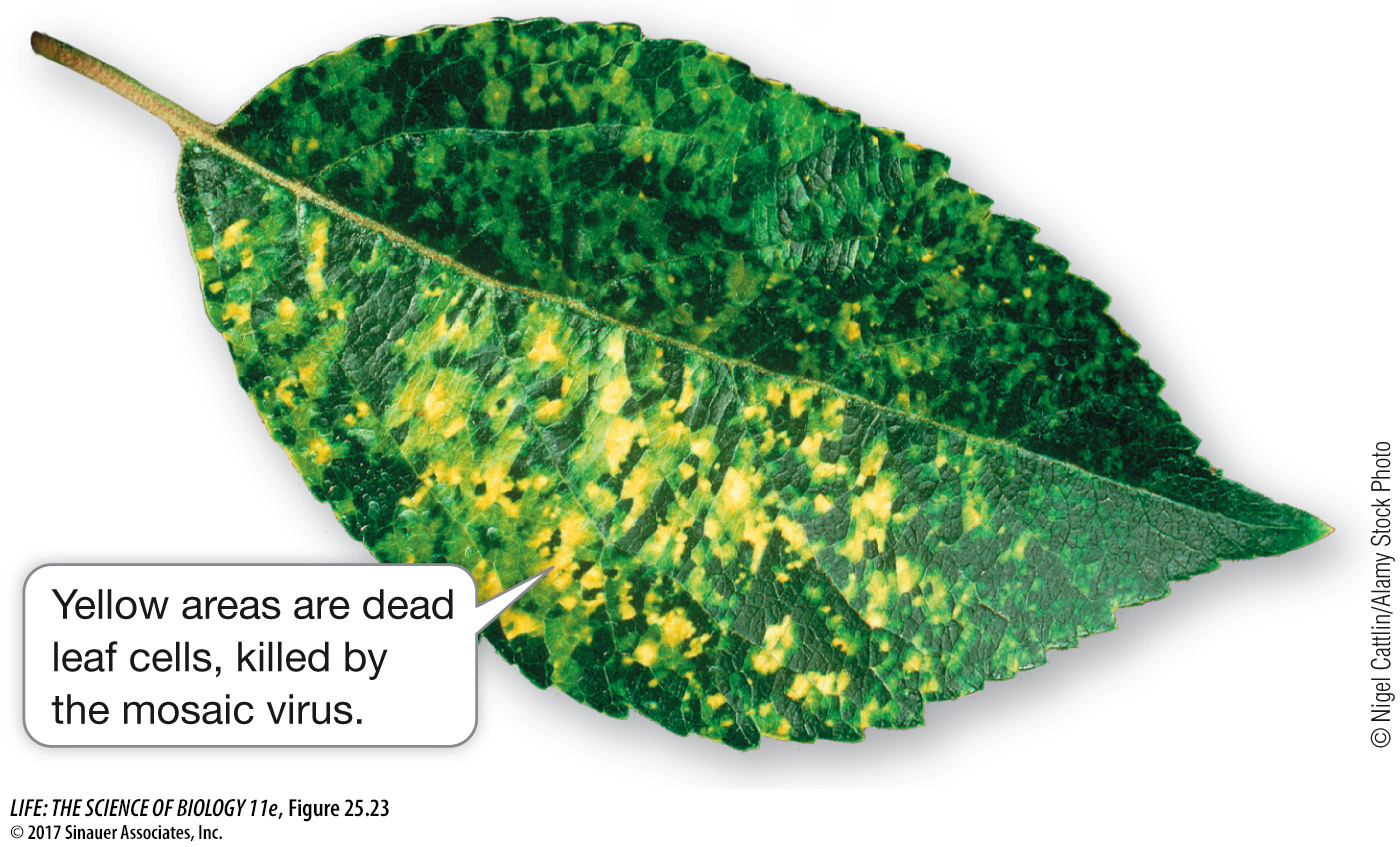Many RNA viruses probably represent escaped genomic components of cellular life
Although viruses are now obligate parasites of cellular species, many viruses may once have been cellular components involved in basic cellular functions—that is, they may be “escaped” components of cellular life that now evolve independently of their hosts.
NEGATIVE-SENSE SINGLE-STRANDED RNA VIRUSES An example of a likely “escaped” biochemical function comes from viruses with genomes composed of single-stranded negative-sense RNA: RNA that is the complement of the mRNA needed for protein translation. Many of these negative-sense single-stranded RNA viruses have only a few genes, including one for an RNA-dependent RNA polymerase that allows them to make mRNA from their negative-sense RNA genome. Modern cellular organisms cannot generate mRNA in this manner (at least in the absence of viral infections), but scientists speculate that single-stranded RNA genomes may have been common in the distant past, before DNA became the primary molecule for genetic information storage.
Page 547
A self-replicating RNA polymerase gene that began to replicate independently of a cellular genome could conceivably acquire a few additional protein-coding genes through recombination with its host’s DNA. If one or more of these genes were to foster the development of a protein coat, the virus might then survive outside the host and infect new hosts. It is believed that this scenario has been repeated many times independently across the tree of life, given that many of the negative-sense single-stranded RNA viruses that infect organisms from bacteria to humans are not closely related to one another. In other words, negative-sense single-stranded RNA viruses do not represent a distinct taxonomic group, but rather exemplify a particular process of cellular escape that probably happened many different times.
Familiar examples of negative-sense single-stranded RNA viruses include the viruses that cause measles, mumps, rabies, and influenza (see Figure 25.22A).
POSITIVE-SENSE SINGLE-STRANDED RNA VIRUSES The genome of another type of single-stranded RNA virus is composed of positive-sense RNA. Positive-sense genomes are already set for translation; no replication of the genome to form a complement strand is needed before protein translation can take place. Positive-sense single-stranded RNA viruses (see Figure 25.22B) are the most abundant and diverse class of viruses. Most of the viruses that cause diseases in crop plants are members of this group. These viruses kill patches of cells in the leaves or stems of plants, leaving live cells amid a patchwork of discolored dead tissue (giving them the name of mosaic or mottle viruses; Figure 25.23). Other viruses in this group infect bacteria, fungi, and animals. Human diseases caused by positive-sense single-stranded RNA viruses include polio, hepatitis C, and the common cold. As is true of the other functionally defined groups of viruses, these viruses appear to have evolved multiple times across the tree of life from different groups of cellular ancestors.

Figure 25.23 Mosaic Viruses Are a Problem for Agriculture Mosaic, or “mottle,” viruses are the most diverse class of viruses. This leaf is from an apple tree infected with a mosaic virus.
Page 548
RNA RETROVIRUSES The RNA retroviruses are best known as the group that includes the human immunodeficiency viruses (HIV; see Figure 25.22C). Like the previous two categories of viruses, RNA retroviruses have genomes composed of single-stranded RNA and probably evolved as escaped cellular components.
Retroviruses are so named because reverse transcription is a necessary component of their reproduction. When the retrovirus enters the nucleus of its vertebrate host, viral reverse transcriptase produces complementary DNA (cDNA) from the viral RNA genome and then replicates the single-stranded cDNA to produce double-stranded DNA. Another virally encoded enzyme called integrase catalyzes the integration of the new piece of double-stranded viral DNA into the host’s genome. The viral genome is then replicated along with the host cell’s DNA. The integrated retroviral DNA is known as a provirus.
Retroviruses are only known to infect vertebrates, although genomic elements that resemble portions of these viruses are a component of the genomes of a wide variety of organisms, including bacteria, plants, and many animals. Several retroviruses are associated with the development of various forms of cancer, as cells infected with these viruses are likely to undergo uncontrolled replication.
As retroviruses become incorporated into the genomes of their hosts, many become nonfunctional copies that are no longer expressed as functional viruses. These sequences may provide a record of ancient viral infections that plagued our ancestors. Humans, for example, carry about 100,000 fragments of endogenous retroviruses in our genome. These fragments make up about 8 percent of our DNA—a considerably larger fraction of our genome than the fraction that comprises all our protein-coding genes (about 1.2 percent of our genome).
DOUBLE-STRANDED RNA VIRUSES Double-stranded RNA viruses may have evolved repeatedly from single-stranded RNA ancestors—or perhaps vice versa. These viruses, which are not closely related to one another, infect organisms from throughout the tree of life. Many plant diseases are caused by double-stranded RNA viruses. Other viruses of this type cause many cases of infant diarrhea in humans.
